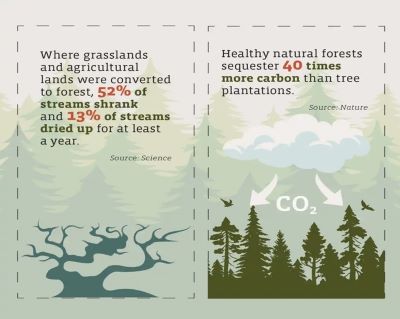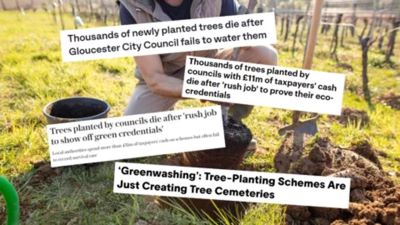Context:
In recent years there has been a spurt in tree planting in the name of special drives by various agencies, including governments, which is a welcome sign for environmental conservation. Unfortunately, however, they don’t always get it right, usually by ignoring key tree planting advice.
Effective Forest Restoration
Addressing Global Forest Degradation
The exploitation of forest resources due to uncontrolled and unsustainable practices has significantly degraded forest landscapes. The World Bank estimates that approximately 10 million square kilometres of forests have been lost since the early 20th century. To combat this, the United Nations declared the decade of 2021-2030 as the Decade of Ecosystem Restoration, aiming to restore 350 million hectares of degraded land. This initiative seeks to generate $9 trillion in ecosystem services and sequester between 13 gigatons and 26 gigatons of greenhouse gases from the atmosphere.
The Appeal of Tree Planting
Tree planting remains one of the most popular and effective methods to support biodiversity and address climate-related challenges. It plays a crucial role in biological carbon sequestration, which helps remove carbon dioxide from the atmosphere. Recognizing the importance of trees in maintaining ecological balance, the Indian Agriculture Minister, K.M. Munshi launched the Van Mahotsava (‘festival of trees’) programme in July 1950. This annual event has succeeded in motivating people and improving forest areas to some extent.
Challenges Faced by Haphazard Tree Planting
● Fancy Drives and Catchy Slogans
Recently, there has been a surge in tree planting initiatives led by various agencies, including governments. These initiatives often feature catchy slogans, glamorous drives, and headline-grabbing campaigns. Examples include India’s single-day planting drives, the World Economic Forum’s “One Trillion Project,” the “Great Green Wall of China,” Pakistan’s “10 Billion Tree Tsunami,” and the “Bonn Challenge” to restore 150 million hectares by 2020 and 350 million hectares by 2030. While these drives attract significant media attention and public involvement, they face criticism for limited community participation, inadequate post-planting measures, and a tendency towards monoculture, which undermines their effectiveness in carbon sequestration and biodiversity development.
● The Problem with Mass Planting Drives
Environmentalists and scientists have raised concerns about the neglect of ecological and local contexts in many tree planting programs. A study led by Joseph Veldman found that tree planting in areas such as grasslands and animal habitats can destroy plant and animal habitats, increase wildfire intensity, and exacerbate global warming. Similarly, research by William Bond and colleagues questioned the practice of treating grasslands as deforested and degraded lands suitable for tree planting, highlighting that these lands are highly productive and biodiverse, supporting both livestock and people.
● Lacking Post- Planting Measures
Planting saplings alone does not meet the multifaceted expectations of restoration. Adequate post-planting measures and monitoring of tree growth are often lacking, particularly in non-government-supported programs. Contrary to popular belief, tree planting is not always a cost-effective climate solution compared to alternative approaches such as tree islands, which involve planting in small patches or islands.

India’s Forestry Challenges
In 2023, Prime Minister Narendra Modi stated at the White House that ‘India is the only G20 country that has fulfilled its commitments under the Paris Agreement’. Additionally, in February 2024, Union Minister of State for Environment, Forest and Climate Change Ashwini Kumar Choubey reported that ‘India has achieved an additional carbon sink of 1.97 billion tonnes of CO2 equivalent’.
Despite these achievements, India faces significant challenges: nearly 10 million hectares of forests are under encroachment, approximately 27.5 crore people depend on forests for subsistence, and nearly 5.7 million hectares of forest land have been lost for non-forestry purposes since Independence. These issues pose obstacles to India’s goal of restoring 26 million hectares of degraded forests by 2030 and improving forest cover through tree planting.
Reevaluating Strategies for Effective Restoration
Best practices in ecosystem restoration are crucial for long-term success. They ensure that efforts are effective and sustainable by promoting transparency, accountability, and community involvement. This balanced approach fosters harmonious coexistence between human activities and natural ecosystems.
● Understanding Ecosystems and Assessments: Thorough ecosystem assessments are essential for effective restoration. They involve analyzing biodiversity, hydrology, soil composition, and historical context, guiding tailored strategies. Assessments help identify ecosystem services, risks, and values, optimizing restoration success.
● Planning and Design
○ Developing a Strategic Plan: A strategic restoration plan outlines objectives, methods, and timelines, aligning with ecosystem assessments. It sets targets for biodiversity, soil health, and water quality while considering climate change impacts to enhance resilience.
○ Community Engagement: Engaging communities ensures restoration efforts meet local needs. Active participation and incorporating local knowledge foster long-term commitment and stewardship, enhancing project success.
○ Designing for Sustainability: Designing for sustainability involves selecting native species, promoting natural regeneration, and considering future impacts. Adaptive and resilient designs help ecosystems thrive amid evolving challenges.
● Implementation: Implementation translates plans into actions like planting and stabilisation. Adhering to the plan while being flexible to address challenges ensures effective execution, relying on skilled personnel and adequate resources.
● Ongoing Management: Restoration requires continuous management, including monitoring ecosystem health, managing invasives, and adapting strategies. Ongoing community engagement and legal protections are crucial for maintaining ecosystem health.
● Monitoring and Evaluation: Monitoring tracks progress using indicators like biodiversity and soil health, while evaluation assesses broader impacts and goal achievement. Digital Monitoring, Reporting, and Verification (DMRV) tools enhance accuracy and accountability in restoration projects.
Conclusion
India’s recent policy changes to address forestry and restoration challenges are affected by inherent problems in current strategies. Addressing the challenges of mass tree planting drives requires a thorough reevaluation of existing strategies. To enhance effectiveness, there needs to be a greater focus on adequate financing, active community participation, and technical considerations. These elements have often been overlooked. Alongside public awareness campaigns, social media engagement, and incentivized community participation, reoriented strategies can help improve ecological systems and create resilient forests with diverse capacities. By prioritising financial resources, community involvement, and technical expertise, we can better support ecological restoration efforts and build resilient, diverse forests. The emphasis should shift from merely planting trees to ensuring sustainable and effective forest management practices.
|
Probable Questions for UPSC Mains 1. Critically assess the role of community engagement in the success of ecosystem restoration projects. How can local knowledge and participation enhance the effectiveness of these projects? (10 Marks, 150 Words) 2. Evaluate the role of thorough ecosystem assessments in shaping successful forest restoration strategies. How do these assessments influence the planning and design of restoration projects, and what are the potential consequences of inadequate assessments on the restoration outcomes? (15 Marks, 250 Words) |
Source: The Hindu







